- Time
- Post link
ATMachine said:
OK, I'm going to go out on a serious limb here--
Because up until now you've been the picture of restraint and careful analysis.
Ooo, good correlation, Tobar.
Keep Circulating the Tapes.
END OF LINE
(It hasn’t happened yet)
Very good catch re: Shadows of the Empire. I hadn't even thought of that, but the Fritz Lang influence is obvious.
---
Alexander Nevsky features the Grand Master of the Teutonic Knights naming one of his order the new Prince of Novgorod--before Novgorod has even been conquered. In Lucas's 1974 rough draft the Emperor does the same for Crispin Hoedaack, the new Governor of Aquilae under Imperial rule.
Eisenstein's striking juxtaposition of black-robed monks and white-robed knights among the German armies also has echoes in both the SW rough draft--where black-armored Imperial troops march down white corridors--and in the final film, which sets the black-clad Darth Vader against white-armored stormtroopers.
And Lucas's rough draft describes the Grande Mouff Tarkin, an Aquilaean priest who wears "long black robes," as contrasted with the white robes of Aquilae's military officers. Here Lucas's use of color symbolism is as deliberately simplistic as elsewhere in the script--more in the vein of Fritz Lang than Eisenstein--because Tarkin is a defeatist who counsels against General Skywalker's plan to save Aquilae from invasion through a pre-emptive strike.
(The priestly origin of this character name explains the derivation of the title Grand Moff: it comes from "Grand Mufti," the chief priest of the Ottoman Empire.)
Plus, the Bene Gesserit in Dune wear black robes, which may have contributed to the black-clad Jedi seen in TPM concept art.
Incidentally, in Fritz Lang's Die Nibelungen, the heroine Kriemhild goes from wearing a white dress in the first film, to wearing mourning black in the second, after her husband Siegfried is killed. This marks her transformation from a youthful, naive innocent to a grieving widow obsessed with vengeance. Lucas surely noted this, though he opted instead to have the rough draft's Leia go through the Madonna-whore transfiguration seen in Lang's Metropolis.
As for Annikin Starkiller's costume, although early on he wears the white uniform of the Aquilaean military, once the group of fugitives set out for Ophuchi with the Princess, he is disguised as a farmer. Likely his farmer outfit would also have been white, making it almost exactly like the costume Mark Hamill wears in the final film.
Because Annikin Starkiller is armed with a laser-sword and laser pistols, he is presumably concealing them. Probably with a brown poncho, reminiscent of Clint Eastwood's Man With No Name:
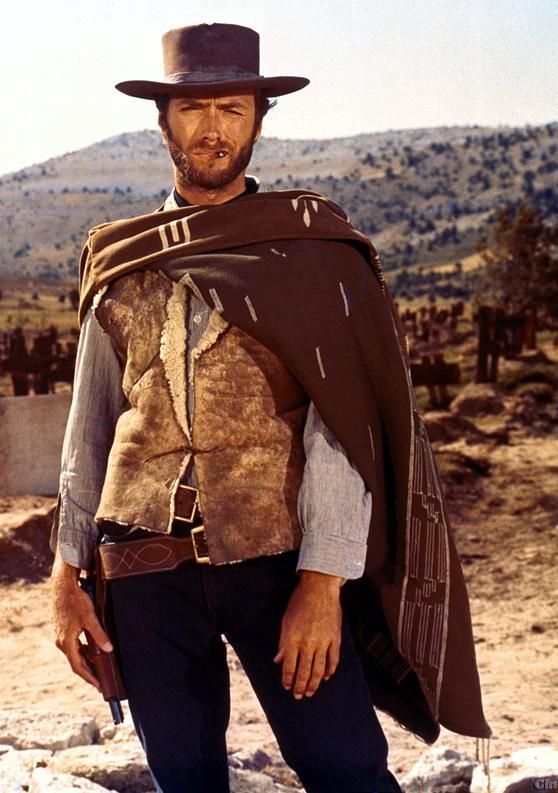
Mark Hamill wore such a poncho over his white outfit in SW 1977, although it hardly shows up in the final film.
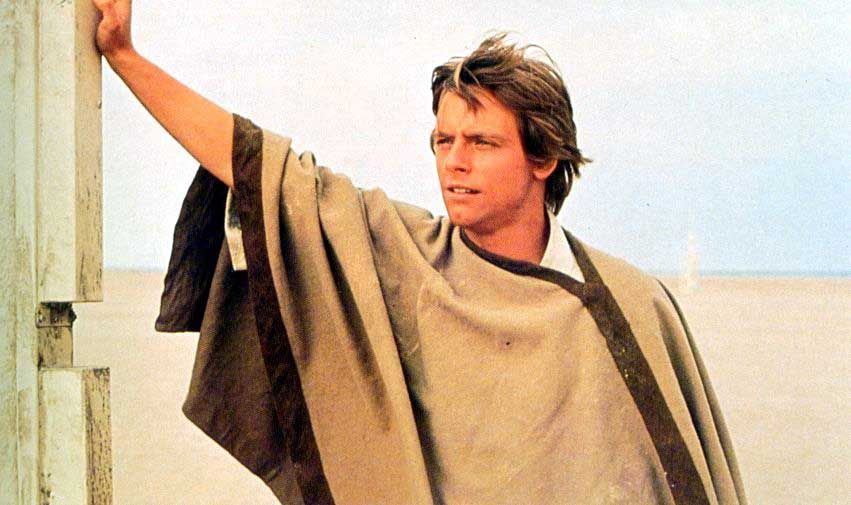
The idea of a white-clad character with a brown Clint Eastwood-inspired poncho would recur in early concept art for ESB. Boba Fett originally had white armor, but his poncho was already brown.
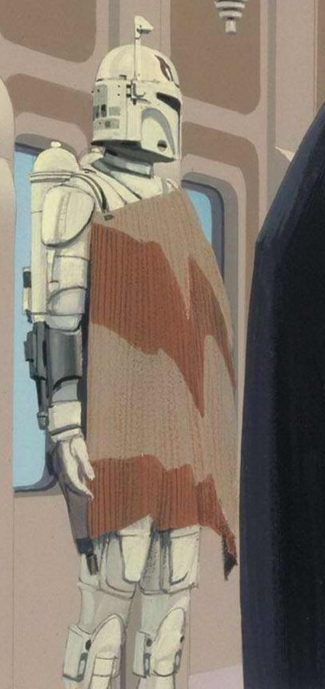
“That Darth Vader, man. Sure does love eating Jedi.”
Some photos from Alexander Nevsky to illustrate its visual influence on the various iterations of SW:
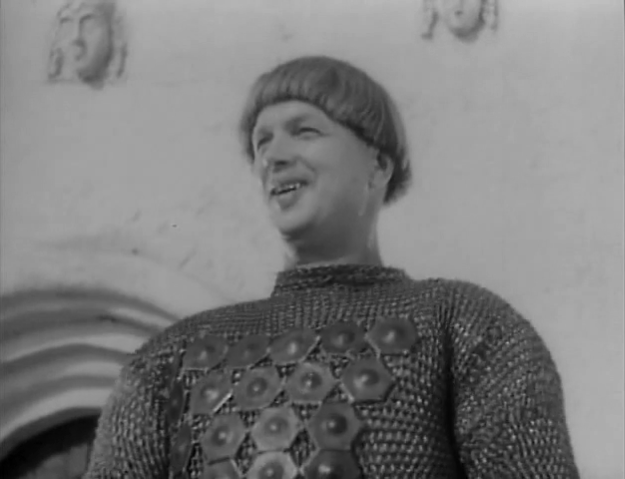
Vasily Buslai, one of the supporting characters, sports the bowl haircut typical of Russian men in this film. Luke Skywalker ended up with a similar haircut.
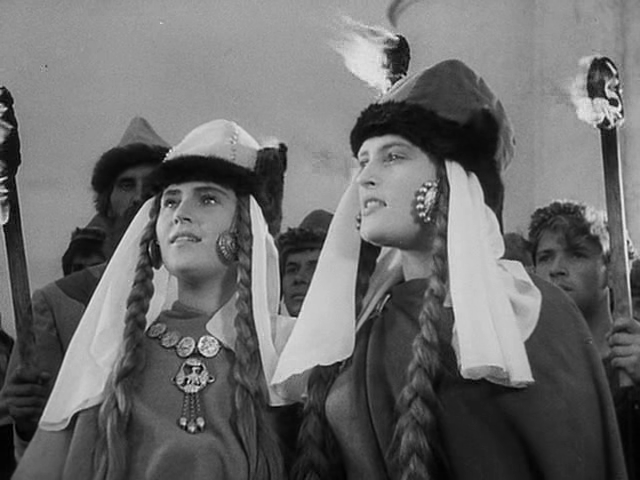
Typical Russian women with their hair braided, much like Kriemhild in Fritz Lang's Die Nibelungen--a hairstyle also intended for Leia Aquilae in the 1974 rough draft.
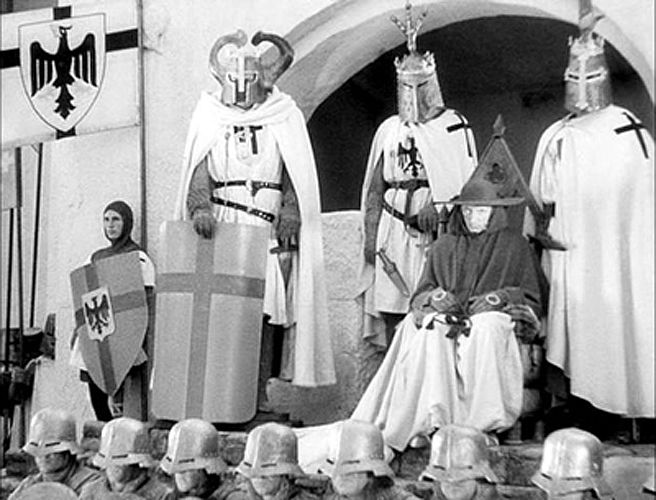
The film's antagonists, the Teutonic Knights, wear white robes and carry shields, like the white-armored, shield-bearing stormtroopers of Lucas's second draft of SW.
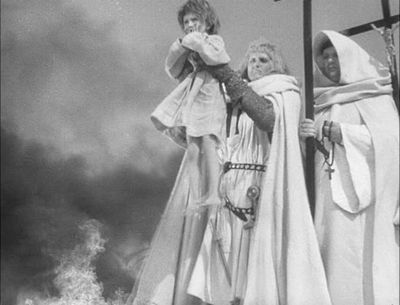
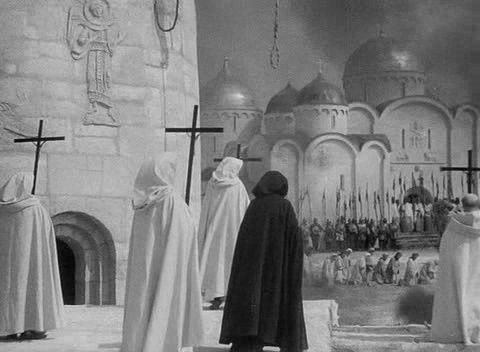
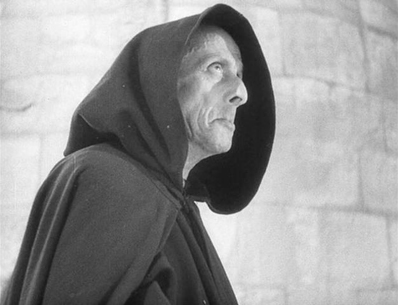
The scenes of white-clad Germans murdering Russian peasants happen under the eyes of a sinister black-robed monk.
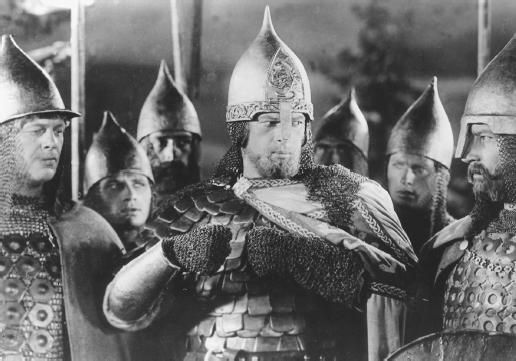
The Russian soldiers (Alexander Nevsky is center in the photo) wear helmets that leave their faces visible, allowing the audience to identify with them.
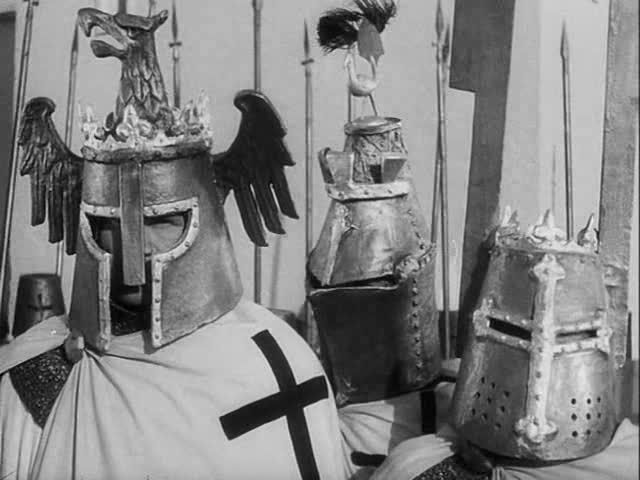

On the other hand, the Germans wear quite Nazi-ish helmets that conceal their faces, making them into a nightmarish Other. Lucas borrowed this idea for the Rebel and Imperial pilot costumes in SW 1977.
“That Darth Vader, man. Sure does love eating Jedi.”
Small addendum to the poncho idea noted above: in AOTC, when Anakin wears a commoner's disguise while escorting Padme home to Naboo incognito, said disguise consists largely of a poncho.
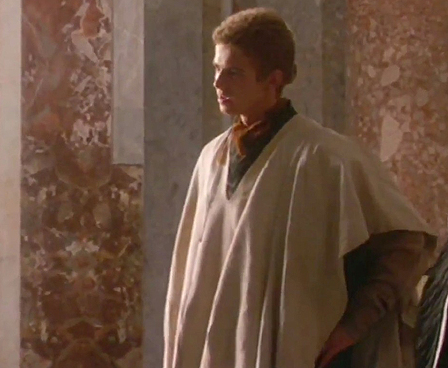
Only here, since Anakin's underlying outfit is brown, it's the poncho itself that is white (instead of the poncho being brown and the outfit beneath white, as in the original concept from the 1970s).
This whole subplot with Padme fleeing Coruscant undercover seems borrowed from the 1974 rough draft. Which is odd, because Lucas had just used that exact plot in TPM.
“That Darth Vader, man. Sure does love eating Jedi.”
ATMachine said:
This whole subplot with Padme fleeing Coruscant undercover seems borrowed from the 1974 rough draft. Which is odd, because Lucas had just used that exact plot in TPM.
Considering how apparently derivative many of his unused plot points from the 1970s were that were reused for the PT, it's not that odd.
Keep Circulating the Tapes.
END OF LINE
(It hasn’t happened yet)
Fair point.
“That Darth Vader, man. Sure does love eating Jedi.”
Oh, there's one additional thing I forgot to mention from Die Nibelungen.
As a condition for allowing Siegfried to wed Kriemhild, her brother Gunther asks Siegfried to help him win the hand of the fierce warrior woman Brunhild. Brunhild lives in far-off Iceland, in a castle on a high rock that is surrounded by a sea of fire.
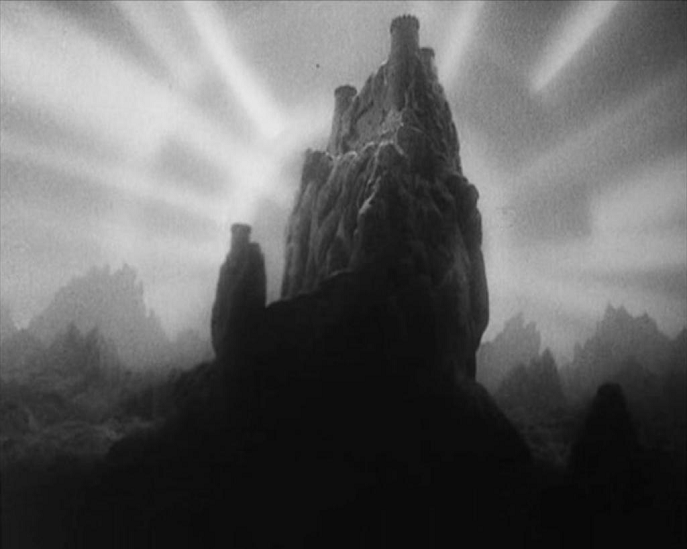
The flames are prophesied to quench themselves at the approach of the world's mightiest warrior--and they do, as Siegfried approaches the castle.
This image is an obvious inspiration for Lucas's idea, seen in the first draft of ESB, that Darth Vader would live in a castle on a tall mountain surrounded by a sea of lava.
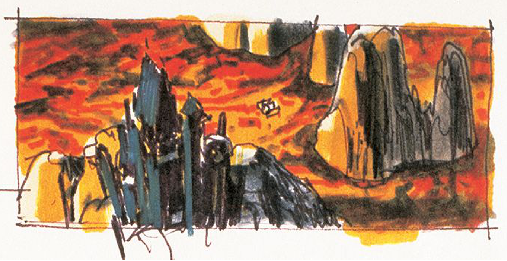
In the notes for the Journal of the Whills outline, Lucas's use of the names "Yoshiro" and "Brunhuld" as, respectively, the names of the good guys' and bad guys' planets (later to become Aquilae and Alderaan in the rough draft) is quite reflective of the sources these two names are derived from. Toshiro Mifune is a hero in Seven Samurai and Yojimbo; Brunhild is (in Fritz Lang's film, at least) portrayed as a villain.
“That Darth Vader, man. Sure does love eating Jedi.”
Let's talk about a few other costumes from the rough draft, namely the Imperials:
The Emperor presumably wore a black military uniform, like his counterpart in Dune, Padishah Emperor Shaddam IV (who invariably was seen wearing a "gray Sardaukar uniform with silver and gold trim").
However, since the majority of Imperial officers would also wear black and gray uniforms, the Emperor would need something distinctive to set him apart on celluloid. Probably he would have worn a cloak or cape of some sort--likely gold in color.
As Emperor in Dune Messiah, Paul Atreides wears golden robes on formal occasions. This idea also shows up in Leigh Brackett's first draft script of ESB, where the Emperor is "draped and hooded in cloth-of-gold."
This costume would give the rough draft's Emperor an extraordinary resemblance to Emperor Ming in the 1940 serial Flash Gordon Conquers the Universe. In this serial Ming wears an elaborate military uniform with a cape (in the earlier Flash Gordon serials he wore relatively simple robes instead).

One thing the Dark Horse comic adaptation got right is that General Darth Vader would likely have had some sort of facial scar. This would echo the dueling scars frequently seen on fictional Nazi officers (a relic of real-life Prussian military culture).
Colonel Dietrich sports just such a dueling scar in Raiders of the Lost Ark; he serves as a brutal henchman and foil to the more refined Belloq, just as General Vader would have been to Crispin Hoedaack.

Although the rough draft describes Prince Valorum as wearing a "fascist black-and-chrome uniform," given his status as a Black Knight of the Sith, he presumably would have worn black robes, like the other Sith knight seen earlier in the script (and Darth Maul in TPM).
The black robes are a dark mirror of the earth-toned robes sported by the Jedi: a reflection of the Empire's perversion of a noble order of warriors.
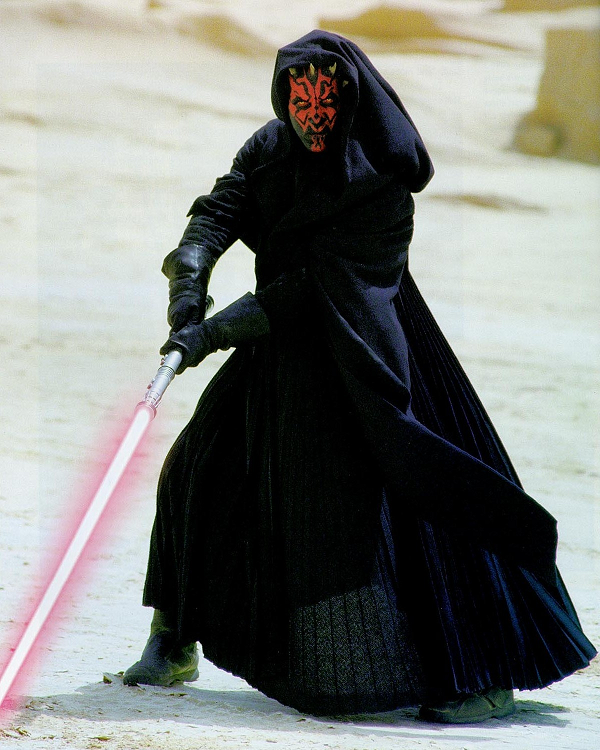
Darth Maul's skin--mostly black, with red tattoos--reflects the idea Lucas probably had to cast Prince Valorum as an African-American.
Later on, Valorum is demoted in rank, and is seen wearing the uniform of a common stormtrooper. (At this stage the stormtroopers likely had black armor.)
I suspect that nobody would have been able to resist the temptation to add a black cape to Valorum's stormtrooper armor, just to make him stand out on screen.
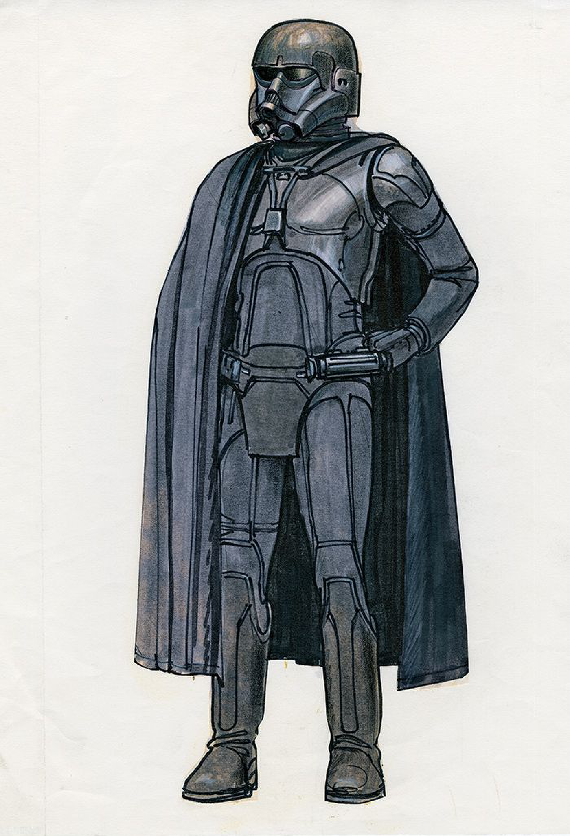
(This is actually a Ralph McQuarrie concept of a Sith Lord from the third draft. But you get the idea.)
In the final scene at the end of the film, Valorum would undoubtedly have been shown wearing white robes, as a sign of his change of allegiance.
“That Darth Vader, man. Sure does love eating Jedi.”
Given that Valorum was probably meant to be black, it is worth at least a moment's notice that the rough draft's finale has Valorum and the white protagonist Annikin Starkiller breaking out of the Imperial space fortress alongside a topless Princess Leia. That might have ruffled a few feathers in more conservative circles.
“That Darth Vader, man. Sure does love eating Jedi.”
The 1974 rough draft shows signs of an additional influence on George Lucas, which I've as yet left unremarked: that of The Lord of the Rings.
General Skywalker is described as having white hair and a short silver beard, and dark eyes. In Tolkien's book (but not the film) Gandalf has dark eyes and a white beard.
There's also the matter of Leia's two young brothers, Biggs and Windy, who have an adventure of their own on Yavin when they are captured by stormtroopers. Since these two children are so young (aged seven and five), they would be very short--reminiscent of Tolkien's hobbits, particularly the duo of Frodo Baggins and Sam Gamgee.
While writing the third draft, Lucas would later toy with the idea of casting all the inhabitants of Tatooine, including Luke Skywalker and Ben Kenobi, as little people, something which he admitted was inspired by Tolkien's book.
This impulse ultimately led Lucas to make Willow--for which the early story concepts apparently featured two Nelwyns, Willow and Meegosh, as opposed to having Willow be the sole Nelwyn/hobbit on screen for most of the film.
Additionally, there's the storyline of Frodo and Sam on their journey to Mordor. At the end of The Two Towers, as Sam watches helplessly, Frodo is captured by Orcs and taken to the fortress of Cirith Ungol, from which Sam ultimately rescues him. A point omitted in the film adaptation is that, in the book, Frodo is naked when Sam finds him; Tolkien implies that the Orcs sexually abused Frodo.
Even back in the 1970s people were suggesting that Frodo and Sam were a gay couple. (Not without good reason--Tolkien modeled their storyline on that of William Morris's novel The Well at the World's End, a quest narrative featuring a heterosexual couple.)
So it's no surprise that Lucas likely took the Frodo/Sam storyline as a model for writing the climactic scenes with Annikin and Princess Leia in his 1974 rough draft. Like Frodo, Leia is stripped, sexually abused, and captured by evil Imperials; like Sam Gamgee, Annikin tracks her down and liberates her from her prison.
Of course, Tolkien's overall light/dark imagery (white for the good guys, black for the baddies) no doubt appealed to Lucas too. The influence of The Lord of the Rings would grow even stronger in Lucas's second draft, where Luke Starkiller has to carry the Kiber Crystal (a powerful Force artifact, akin to the One Ring) to his father on the faraway planet Yavin (i.e., Tolkien's Mount Doom).
“That Darth Vader, man. Sure does love eating Jedi.”
Actually, now that I think about it, young Biggs and Windy's adventures on Yavin more closely resemble those of Merry and Pippin in Fangorn Forest.
Merry and Pippin are captured by Orcs at the beginning of The Two Towers, but as the Orc army is traveling to Isengard it is attacked by the Rohirrim, and in the chaos the hobbits escape into Fangorn. There they meet Treebeard, leader of the Ents, a "shepherd of the trees."
Treebeard entertains the duo, telling them Entish stories and giving them drinks of the marvelous Ent-draught, which causes them to grow taller.
When they arrive on the jungle planet of Yavin, Biggs and Windy (the names are even similar--Windy is actually short for Windom, like Meriadoc Brandybuck or Peregrin Took) are kept safe in the house of Owen Lars. Owen is a human settler and anthropologist who studies the Wookees.
Owen and his wife Beru feed the two young boys generously during their stay. Unexpectedly, Imperial troops invade the house and capture them all, but as they are heading back to their base with their captives, the Wookees set upon them and free the hostages.
And, of course, the heroes' rousing of the Wookees to fight against the Imperial troops and take over their base is highly reminiscent of the Ents' attack upon Isengard.
More disturbingly, the one element of Leia's ordeal I neglected to mention in the last post--the use of electric-shock torture on her by General Darth Vader--is likely drawn from the Orcs' use of a whip on Frodo in Cirith Ungol.
“That Darth Vader, man. Sure does love eating Jedi.”
OK, I'm going to go out on a serious limb here--I'm going to postulate that Lucas likely read William Morris's 1896 fantasy novel The Well at the World's End. It would have been easy for him to get ahold of, as there was an Ace paperback edition released in 1970.
Morris's story opens with King Peter of Upmeads, who asks three of his four sons to go out into the wider world, so that they might learn skills and prove their valor, and so he might see which one is worthiest to succeed him.
The fourth and youngest son, Ralph of Upmeads, is the protagonist. Peter tries to keep Ralph at home, not wanting all his sons to leave him, but Ralph runs away to have an adventure of his own. It's no surprise that at the end of the story Ralph is the one crowned King.
As he travels Ralph learns of the Well at the World's End, a magical fountain in a far-off land that grants long life and strength of will to whoever drinks from it. He decides to seek out this Well.
Morris, like Fritz Lang, uses the Madonna/whore dichotomy in symbolizing his two principal female characters. The Madonna is the Lady of Abundance, a sorceress who is presented in terms of a Marian goddess figure. Ralph falls in love with her, but she is killed by a jealous ex-lover before they can consummate their relationship.
During his travels Ralph also meets a peasant girl named Ursula, who becomes infatuated with him. Initially he spurns her, still in love as he is with the Lady of Abundance. However, after the sorceress dies, Ralph dreams of her, and she tells him to seek out Ursula.
Ralph sets off in pursuit of Ursula, but soon learns she was captured and sold as a slave to the Lord of Utterbol. Ralph himself is enslaved by this evil lord, but manages to escape before long. Ursula also escapes her captors, having stolen a suit of armor. However, Morris later implies that she was raped by both the lord and his nephew during her captivity.
The two meet up and set out together for the Well at the World's End. Pursued by the troops of the Lord of Utterbol, they manage to traverse a barren maze of rocky paths that bars the passage over the mountains, guided by a wise man known as the Sage of Swevenham. After that they come to a pleasant valley. (Ralph and Ursula do not get to take revenge on the Lord of Utterbol; that honor goes to one of Ralph's friends whom he meets on the way.)
One day, while bathing in a lake, Ursula is chased by a hungry bear. Ralph sees her fleeing, naked, for her life and kills the bear. Afterward, Ralph admits that the sight of Ursula naked made him realize that he loves her. Soon thereafter they find a village of "innocent folk" who marry them in a pagan rite.
Before they reach the Well at the World's End, they must cross a vast desert. In the middle of this desert is the Dry Tree, an ominous withered tree with poisoned water about its roots. The tree's evil magic bewitches men into drinking its water; Ralph is only saved by Ursula's warning.
The duo finally find the Well at the World's End (sunken into a coastal cliff, it is only revealed at low tide). They drink and feel themselves imbued with new vitality.
The remainder of the book concerns Ralph's journey home to Upmeads, where he routs a gang of bandits that have taken over the kingdom in his absence. His father Peter, recognizing Ralph as the best suited of his sons to rule, abdicates, and Ralph and Ursula become the new king and queen, living for an extraordinarily long time.
This story was obviously a major inspiration for J.R.R. Tolkien--and not just in The Lord of the Rings; the Silmarillion narrative of Beren and Luthien also owes Morris a hefty debt. Things like Frodo's captivity in Cirith Ungol, and the Scouring of the Shire, have their origins here.
Lucas likely also read Morris's novel; its influence shows in several of his works.
The gang-rape Leia Aquilae goes through offscreen in the 1974 rough draft is strikingly similar to what happens to Ursula--mediated, of course, by the prism of Tolkien, who also borrowed from Morris in this regard. Lucas follows Morris in applying his rape narrative to a woman, as opposed to a male hero like Tolkien did. But Lucas borrowed from Morris in other ways as well.
Consider the Dry Tree: a poisonous tree in the midst of a vast desert wasteland. This image appears to have recurred in early story concepts for Willow, where a sinister tree apparently sat in the middle of a vast desert. In Lucas's version, the tree was sinister because it marked the entrance to the cave of a hungry dragon.
The idea of a barren rocky maze--in Willow surrounding the lost castle of Tir Asleen--likewise appears to owe something to Morris. Fin Raziel, the sorceress, assumes the function of the Sage of Swevenham in leading the main characters safely through the stony labyrinth.
As well, Willow's Madmartigan first falls in love with Sorsha when he sees her sleeping in her tent--and originally she was meant to be sleeping naked. (The final film put her in a nightgown.) This is reminiscent of Ralph first realizing that he loves Ursula when he sees her running naked from a bear.
Lastly, there's the fairy-tale motif of the youngest son having to prove himself the equal (or better) of his older brothers. This shows up markedly in the 1975 second draft of SW, where Luke is one of the youngest sons of the Starkiller family of Jedi, and must prove to his father and brothers that he is a worthy son--in fact, fated to be the worthiest of all.
And in the third draft, although Luke's large family is gone, Luke runs away from his home and his foster parents to seek adventure in the wider world, much like Ralph does.
I have to say, I have a newfound respect for Lucas, sheerly in terms of literary scholarship, seeing that he pursued Tolkien to his sources like this. Not many people would have made the Morris connection in the 1970s; few more do now.
“That Darth Vader, man. Sure does love eating Jedi.”
It hits me that the total number of trappers (nine) who capture and defile Princess Leia in the rough draft is actually another LOTR reference--to the symbolism of evil associated by Tolkien with the nine Nazgul, the fearsome Ringwraiths who are Sauron's chief lieutenants.
However, the trappers' appearance as described in the script is more reminiscent of Tolkien's Orcs: "although they appear slightly human, they are slimy, deformed, hideous looking creatures."
Also, the basic plot of the second draft (i.e., Luke sets out to deliver the magical Kiber Crystal to his father) can quite nicely be summed up as a three-way fusion between these three books:
-Lord of the Rings (the hero needs to take a powerful magic artifact he inherited to someplace far away--in the case of the One Ring, in order to destroy it);
-Robert E. Howard's Conan novel The Hour of the Dragon (the hero needs to find and deliver a powerful magic artifact to the forces of good, so it can be used--in the case of Conan the Barbarian, the long-lost Heart of Ahriman);
-and William Morris's The Well at the World's End (the hero needs to rescue his father from the forces of evil--as Ralph of Upmeads does at the end of the book by saving King Peter's realm from a horde of invading brigands).
“That Darth Vader, man. Sure does love eating Jedi.”
I just realized that the scene in Titanic where Kate Winslet poses nude for Leonardo DiCaprio, wearing only a fabulously valuable necklace, has an extraordinary similarity with a rejected idea for a nude scene in Willow.
In that film, in the scene where Madmartigan enters Sorsha's tent and falls in love with her, she was originally going to be sleeping naked, and would likely have been seen bare-breasted, with a royal medallion on her chest.
The medallion was going to be from her father's kingdom, the hidden Elf city of Tir Asleen. Sorsha was a half-Elf and the kingdom's lost princess, and the medallion was a sign of her heritage. (Insert your own Spaceballs joke here.)
The idea for seeing Sorsha bare-breasted in turn comes from the 1974 SW rough draft, where Leia Aquilae runs around topless during the climactic escape from the Death Star.
The royal medallion derives from the same source. Annikin Starkiller takes it off Leia's neck when he escorts her to safety early in the script.
In the final film Lucas settled for just giving Sorsha Leia Aquilae's red hair--which also passed down to Kate Winslet.
Funny to think about James Cameron reusing George Lucas's more adult ideas once Lucas had determined on "family-friendly" filmmaking.
“That Darth Vader, man. Sure does love eating Jedi.”
In the 1974 rough draft, the spaceship which the heroes steal from the Aquilae spaceport is parked vertically in an underground hangar. Although the spaceship itself is standing on one end, the internal structure features a corridor running down the length of the ship horizontally, apparently using artificial gravity oriented 90 degrees out of kilter with the planet surface.
A similar subtle use of a 90-degree reorientation of gravity is seen on the gun turrets of the Millennium Falcon in the final film.
The spaceship being parked vertically, with its engines pointing downward, is obviously evocative of the Apollo moon rockets, although its hangar is more reminiscent of a Cold War missile silo, complete with cover plate.
Various making-of books for TPM suggest that Lucas originally wanted to feature an underground city on the desert planet in the first film. Presumably this actually refers to the subterranean spaceport of the rough draft.
“That Darth Vader, man. Sure does love eating Jedi.”
ATMachine said:
OK, I'm going to go out on a serious limb here--
Because up until now you've been the picture of restraint and careful analysis.
You know what? Fine. You win. Since you guys obviously have no interest in anything I say, I'll shut up and go away. I'll show myself out, thank you.
And incidentally, if any of you are wondering why the OT.com forum doesn't get more members... this is why. The forum culture here is toxic, cynical, and clique-ish, and treats outsiders with barely concealed contempt. Take a good long look at yourselves in the mirror, guys.
“That Darth Vader, man. Sure does love eating Jedi.”
Edited to remove double post. I'm sure you guys will laugh at me for that, but since jeering at others is obviously second nature around here, I'll let it slide. Bye.
“That Darth Vader, man. Sure does love eating Jedi.”
ATMachine said:
You know what? Fine. You win. Since you guys obviously have no interest in anything I say, I'll shut up and go away. I'll show myself out, thank you.
I actually enjoyed reading your posts. *shrug*
I'm glad to hear that you enjoyed what I had to say. I was feeling really angry and bitter when I wrote the above posts, and I probably shouldn't have tarred everyone with the same brush.
I may be back.... eventually. But I do plan to take a long break from this forum. I'm tired of the constant cynicism and backbiting, and I really want to spend my Internet time in a healthier environment than here.
“That Darth Vader, man. Sure does love eating Jedi.”
One negative comment after 40 posts and 8,312 claims? I'd say that's a pretty decent run, but that's just me.
I took my share of film classes. I say that not as some credentials, but so you can appreciate where I'm coming from.
You're obviously extremely well read, and well watched (is that a term?) on the world of film. However, you're showing a certain lack of rigor in your reasoning.
Drawing a connection between Leia's hair and the chick in the Flash Gordon comic seems a reasonable connection to talk about.
But that every character's hair color (or lack of hair) is instantly traced to a source starts stretching things.
When you hit on the interesting concept of Han Solo being inspired by the Creature from the Black Lagoon, you weaken that when you start to stretch it into your "monsters recast as heroes" thesis. Artoo is the giant Martian tripods? Chewbacca is King Kong? These seem more far fetched.
"Bizarre and colorful Wookee designs have been painted across the large deflector fins of the spacecraft. Some designs transform the ships into huge and grotesque animals, while others create unique mosaic patterns."
This description seems to evoke something far more primitive and tribal, like the ships at the end of "Avatar" than the industrialized, geometric patterns you connect them too.
I'd say one of your best points if about the faceless Teutonic knights vs the exposed faces of the heroes in Alexander Nevsky. But the whole thing seems a little tainted next to random pictures of women with braids because people wore braids in movies because so therefore.
I think your Goddess Imagery/Virgin Mary discussion about Leia was fascinating. With her boobs out resembling Liberty leading the people was a very astute observation. Almost wish that'd been in the movie.
You follow a vaguely circular reasoning when you start a post with "I postulate Lucas read 'Well at the World's End'" then end the post with "I sure am impressed Lucas read that." You didn't prove anything between the start and the end of you post.
It hits me that the total number of trappers (nine) who capture and defile Princess Leia in the rough draft is actually another LOTR reference--to the symbolism of evil associated by Tolkien with the nine Nazgul, the fearsome Ringwraiths who are Sauron's chief lieutenants.
After like this, I'm forced to wonder what number WOULDN'T be a reference to something? What hairstyle isn't a deliberate echo?
Also, and I'm as guilty/representative of it as anyone, but we do, as a community have a slight tendency to occasional wiffs of snarkiness.
I for one like to hear what ATMachine has to say, and actually watched Alexander Nevsky based on a previous post.
You probably don’t recognize me because of the red arm.
Episode 9 Rewrite, The Starlight Project (Released!) and Terminator Ultimatum,
Also, in one scene, the white-clad knights and white-robed German priests lynch old men and women, and throw babies onto bonfires. This orgy of violence is orchestrated by a black-robed monk.
I really hate to bump an older thread but I’ve been catching up and this quote just struck me as familiar… you paralleled it to the Tantive IV siege in Star Wars, but now that TFA has been released I believe there is a much stronger connection, which tells me that the new film-makers are not only studying what Lucas did prior, but also what he studied as well. I won’t spoil the scene for those who haven’t seen it, but those who have know what I’m referring to.
http://cdn.movieweb.com/img.news.tops/NE46zuJ1mtls75_2_b.jpg
Let’s talk about a few other costumes from the rough draft, namely the Imperials:
Although the rough draft describes Prince Valorum as wearing a "fascist black-and-chrome uniform," given his status as a Black Knight of the Sith, he presumably would have worn black robes, like the other Sith knight seen earlier in the script (and Darth Maul in TPM)…
Darth Maul’s skin–mostly black, with red tattoos–reflects the idea Lucas probably had to cast Prince Valorum as an African-American.Later on, Valorum is demoted in rank, and is seen wearing the uniform of a common stormtrooper. (At this stage the stormtroopers likely had black armor.)
This concept is returned to in TFA as Finn/FN-2187.